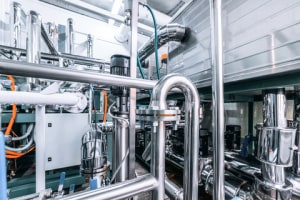‘Cargo Refrigeration Plant Systems’ is a free online course that introduces you to the principles of cooling by evaporation and latent heat of evaporation, as well as the relationship between the refrigerant cycle and coefficient of performance. It will familiarize you to the pressure-enthalpy chart in the ideal and non-ideal refrigeration cycle, as well as how the vapour-compression refrigeration cycle works. The main components of the direct expansion system, which include the compressor, oil separator, condenser, filter dryer, thermostatic expansion valve and evaporator, will be covered. You will learn about the functions and operations of the direct and indirect expansion systems, as well as the cascade refrigeration system. The individual compressors with multiple expansion valves and compound compression with flash intercooling, as well as the merits of a brine system, will also be covered in this comprehensive course. Study the four main components of a vapour-compression system, as well as new and traditionally conventional developments in the reefer shipping segments, and get an overview of conventional reefer operators and reefer boxes.
This course then explains cargo space cooling arrangements such as direct expansion grids, as well as direct expansion batteries and air. You will also learn about cold brine grids, brine battery and air, design of an air-circulating system and defrosting. The material teaches you about the functions of container cooling systems, air cooler fans, refrigerated piping containers, as well as air circulation in a reefer container. The stowage of refrigerated cargo, insulation, preparation of cargo compartments, and precautions to be taken while handling refrigerated cargo will also be covered in this course. Learn about the preparation of cargo holds, precooling, precautions to take during loading, as well as measures to be taken to prevent fluctuation in temperature. Do you know the steps to take prior to and while receiving cargo, as well as how to handle frozen cargo? Steps required for the inspection of cargo during loading, use of brine traps, as well as the importance and guidance of reefer cargo temperature recording will also be covered.
Furthermore, this course will help you get familiar with instruments used to measure and log the temperature of refrigerated cargo such as mercury or spirit thermometers, and electrical resistance and electronic self-balancing thermometers. You will learn about carbon dioxide concentration in the cargo chamber, as well as the functions of a reliquefaction plant. Analyze the single-staged direct reliquefaction system, as well as how the cargo condenser is refrigerated in the direct cycle and cascade direct cycle. You will also learn about how full refrigerated ship carry cargo, as well as the four different containment systems used for the ships, which include independent tanks with single hulls, double bottom and hopper tanks, independent tanks with a double hull, integral tanks and semi-membrane tanks (both incorporating a double hull). The course will also teach you about how to improve the operational flexibility of a fully refrigerated ship. This free online course will be useful to marine engineering students and anyone wanting to know more about refrigerated cargo transport.
What You Will Learn In This Free Course
View All Learning Outcomes View Less All Alison courses are free to enrol, study, and complete. To successfully complete this Certificate course and become an Alison Graduate, you need to achieve 80% or higher in each course assessment.
Once you have completed this Certificate course, you have the option to acquire an official Certificate, which is a great way to share your achievement with the world.
Your Alison certificate is:
- Ideal for sharing with potential employers.
- Great for your CV, professional social media profiles, and job applications.
- An indication of your commitment to continuously learn, upskill, and achieve high results.
- An incentive for you to continue empowering yourself through lifelong learning.
Alison offers 2 types of Certificate for completed Certificate courses:
Digital Certificate: a downloadable Certificate in PDF format immediately available to you when you complete your purchase. Physical Certificate: a physical version of your officially branded and security-marked Certificate All Certificate are available to purchase through the Alison Shop. For more information on purchasing Alison Certificate, please visit our FAQs. If you decide not to purchase your Alison Certificate, you can still demonstrate your achievement by sharing your Learner Record or Learner Achievement Verification, both of which are accessible from your Account Settings.













 Avg. Hours
Avg. Hours  CPD Accredited
CPD Accredited 
 Total XP:
Total XP: 
 Knowledge & Skills You Will Learn
Knowledge & Skills You Will Learn 







